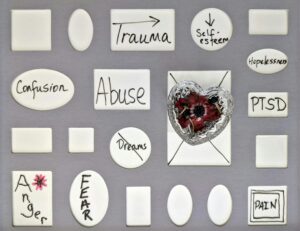Post-Traumatic Stress Disorder (PTSD) is a mental health condition that can develop after experiencing or witnessing a traumatic event. This condition is much more common than people realize and affects millions of people worldwide. Understanding PTSD, recognizing its symptoms, and knowing how to seek help are all crucial steps towards healing and support.
What is PTSD?
PTSD is a psychiatric disorder that may occur in people who have experienced or witnessed a life-threatening event such as natural disaster, assault, a serious accident, combat, etc. It is characterized by cognitive, emotional, and physical reactions that can occur long after the traumatic event has occurred.
Diagnostic Criteria of PTSD
The Diagnostic and Statistical Manual of Mental Disorders, Fifth Edition, Text Revision (DSM-5-TR) outlines the criteria for PTSD:
- Experience or witness a life-threatening event or sexual violence, learn that such an event occurred to a loved one (family member or friend), or experience repeated or extreme exposure to the details of the traumatic event.
- Intrusive Memories (would need to experience at least one):
- Recurrent, involuntary, and unwanted distressing memories of the traumatic event.
- Flashbacks, or reliving the traumatic event as if it were happening again.
- Upsetting dreams or nightmares about the traumatic event.
- Severe emotional distress or physical reactions to something that reminds you of the traumatic event.
- Avoidance (would need to experience one or both):
- Trying to avoid memories, thoughts, or feelings associated with the traumatic event.
- Avoiding external reminders (like places, activities, or people) that remind you of the traumatic event.
- Negative Changes in Thinking and Mood (at least 2):
- Memory problems, including not remembering important aspects of the traumatic event.
- Exaggerated negative thoughts about yourself, other people, or the world.
- Excessive guilt or shame about the cause or consequence of the event (blaming self or others).
- Persistent negative emotional states (e.g., fear, horror, anger, guilt, shame, etc.)
- Feeling detached from family and friends.
- Lack of interest in activities you once enjoyed.
- Difficulty experiencing positive emotions (e.g., love, happiness, satisfaction, etc.)
- Changes in Physical and Emotional Reactions (at least 2):
- Irritability, angry outbursts, or aggressive behavior.
- Reckless or self-destructive behavior.
- Always being on guard or on the look-out for danger.
- Being easily startled or frightened
- Trouble sleeping (difficulties falling or staying asleep or restless sleep).
- Difficulty concentrating.
- The symptoms listed above in 2-5 must occur for longer than 1 month
- The disturbance of these symptoms must cause significant distress or impairment in your social life, at work, or other important areas of your life.
- The disturbance is not due to alcohol, substances, or another medical condition.
Furthermore, in addition to these symptoms, one may experience dissociative symptoms (feeling detached, feeling like your surroundings are unreal or feeling unreal yourself, time moving slowly, etc.) as an additional aspect of PTSD.
Treatment
PTSD is typically diagnosed by a mental health professional conducting a detailed interview and assessment, there are various options for treatment. If you choose to seek professional help, you can expect to receive various types of psychotherapy, medication, or both. There are several effective, evidence-based options for psychotherapy, you can read more about some of those options here.
Briefly, here are some common and effective psychotherapy treatment options:
- Cognitive Behavioral Therapy (CBT)
- Cognitive Processing Therapy (CPT)
- Dialectical Behavior Therapy Prolonged Exposure (DBT-PE)
- Eye Movement Desensitization and Reprocessing (EMDR)
For medication, typically you can expect:
- Antidepressants like selective serotonin reuptake inhibitors (SSRIs)
- Anti-anxiety medications and other medication to address specific symptoms
Other things that can help:
- Physical health- Take care of your physical health can improve overall well-being. Work on your sleep schedule, engage in regular physical activity, and engage in effective eating.
- Mindfulness- Incorporate meditation, breath work, and increased awareness surrounding thoughts, emotions, physical sensations, behaviors, etc. will all help promote relaxation and awareness.
- Support- Connect with family members, friends, or supportive people in your life that you trust. Look for supportive and safe groups- mental health groups, internet groups, knitting groups, whatever! Healing happens in community.
- Educate yourself- this blog is a great place to start! Read books, articles, watch Tik Toks, all of these can be great places to start educating yourself and can help you make sense of what your experiencing! (Note: take what you read/watch on the internet with a grain of salt! Not everything out there is accurate).
 Healing Journey
Healing Journey
Healing from PTSD is possible. It’s all a journey, though, and will likely require time and intentional effort to find the combination of coping strategies, support, therapies, etc. that work for you. If you or someone you love is struggling with PTSD, reach out for professional help. You don’t have to go through this alone, come see one of our many highly trained therapists to walk this journey with you.
About the Author
Maria Mangione (she/her), M.A., LPCC-S is a licensed clinical counselor who specializes in dialectical behavior therapy. Maria works to help people develop the tools they need to develop trust in themselves and build their life worth living. Maria believes in having meaningful connections with her clients and believes that therapy and healing can be fun. Click Here to learn more about Maria’s experience and therapeutic style.


